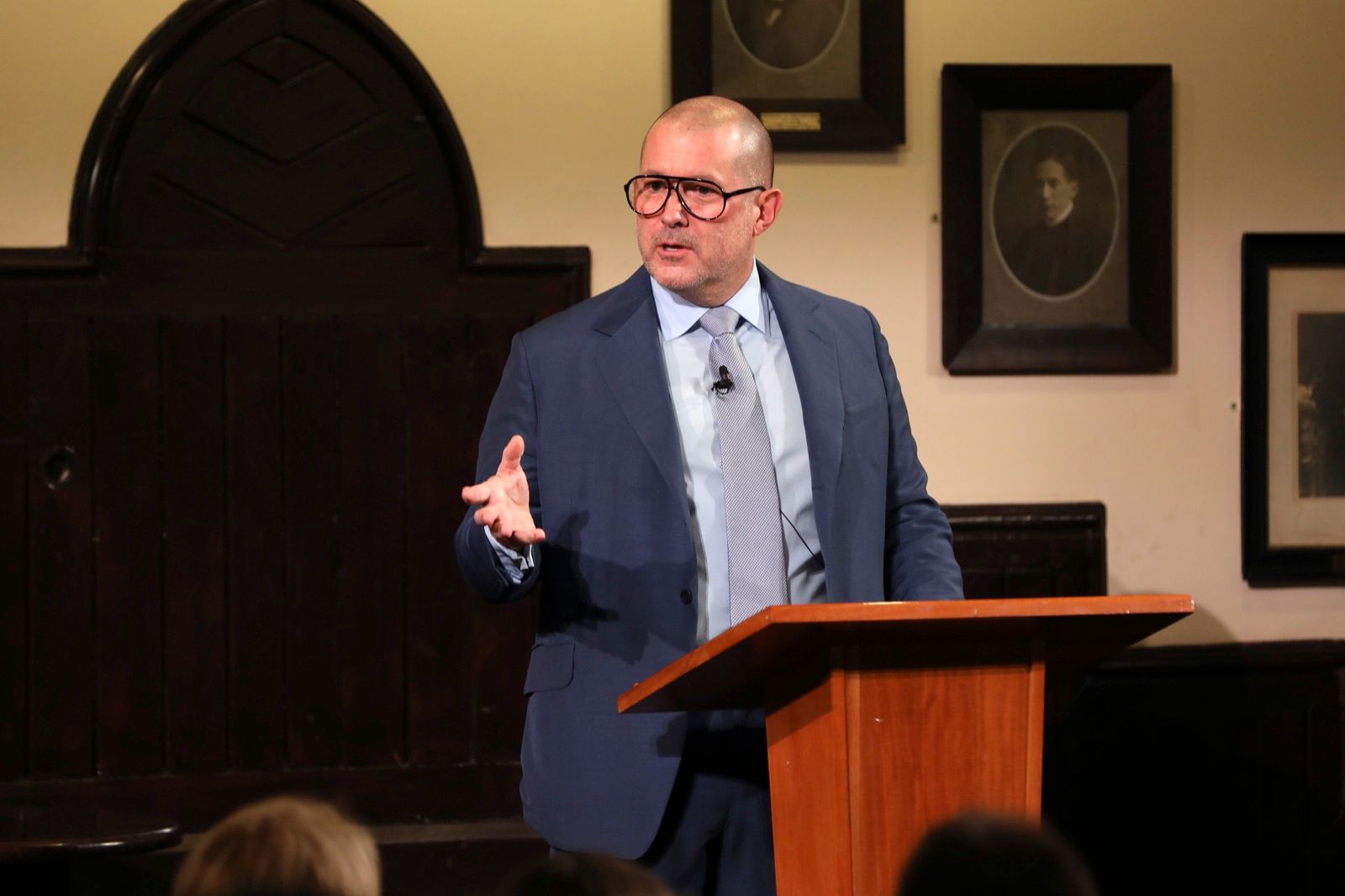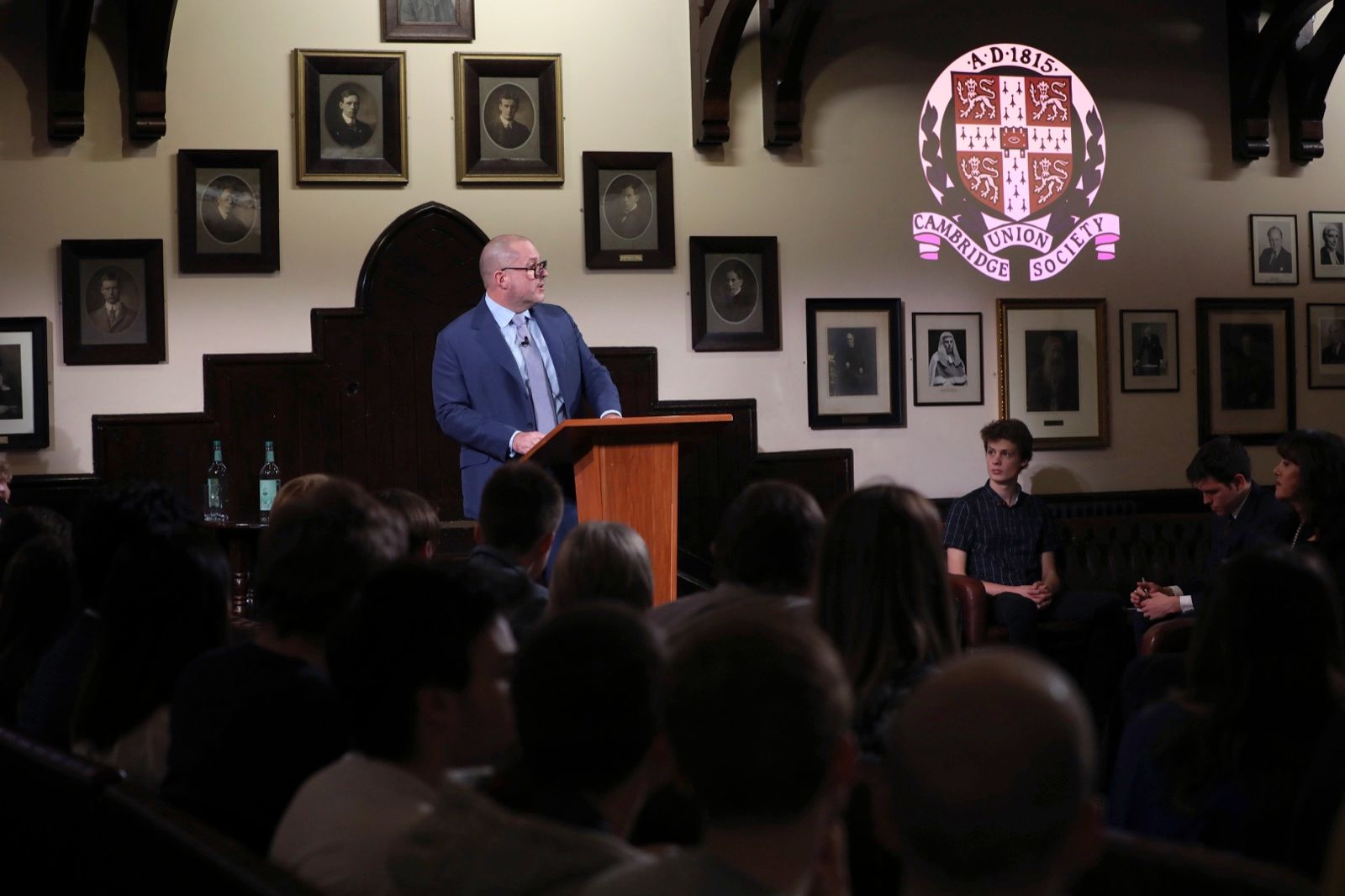"I've been thinking about a small user interface project we started working on about in 2002-2003 and it's a particularly powerful example of how a partial thought can evolve to eventually support multiple ideas and multiple products," explains Sir Jonathan Ive, Chief Design Officer at Apple as he collected this year's Stephen Hawking Fellowship.
Ive is at the Cambridge Union to pick up the award, now in its second year, and Pocket-lint was one of two news organisations in attendance and hear his acceptance speech on how he designs, the day-to-day battles he faces and a brief glimpse into the mind of one of the world's greatest designers.
The project Ive is talking about is the creation of what eventually Apple came to describe as multi-touch, a technology Apple didn't introduce until the launch of the iPhone in 2007 some five years after Sir Jonathan and his team started work on it.
How the iPhone almost never happened...
"Some of you may remember the first time you experienced the interface. Perhaps it was on one of the first iPhones or later on an iPad. But multi-touch describes the ability to directly touch and interact with your content to be able to pinch to zoom an image or flick through a list with your fingers," explains Ive. "Now, I think multi-touch not only defined a new natural and intuitive interface, importantly it defined an opportunity to create applications with their own unique, very specific interface. So, not being generic but by being specific, inherently describes the application's function. We came to see that we could make applications purposeful, compelling and intuitive to use. And so, as the potential for a vast range of apps became clear, so did the idea for an app store."
Intriguingly, it suggests that Apple had an App Store for its iPhone and iPad products in mind for years before the world saw it. Perhaps not a surprise for a company known to be painstaking and perfectionist in its approach to most things.
"It's important to remember the initial ideas were, of course, tentative," Ive goes on. "They were the result of ad hoc, informal meetings between designers, both industrial designers and interface designers. And, interestingly, the nature and concepts of these early ideas shared many characteristics from other ideas from other projects, over the last couple of decades. The founding ideas were not in response to a defined or stated problem. Nobody asked us to solve a problem. They were not in response to a technological opportunity… In reality, the supporting technology, the enabling technology, took years to catch up with the ideas. And I have to say the ideas posed problems and defined challenges but, in that process, we came close to giving up on a number of occasions."
Leaving aside the slightly heart-stopping idea that Apple might have given up on something important like, I don't know, the iPhone, it's interesting to see this urge to solve problems that aren't perhaps even realised as something that drives Ive in his daily work. Ashe says:
"One of the things that has driven me and I think particularly informed my thinking about the process has been to try to better understand the nature of ideas. I think understanding their nature certainly affects the way I have them, treat and respond to them. So, I think almost by definition,ideas are fragile. If they were resolved, if they were robust, they wouldn't be ideas any more, they would be shipping products, a finished album, a completed building. I'm not really entirely sure why, but I think I've always taken an enormous delight when the most tentative thought, often from the quietest voice, evolves into significant and substantial products."
To help him on that journey, the British designer states that to help him, he finds it valuable to revisit past projects and programs, "to carefully and painstakingly remember how first thoughts and ideas came about, how they evolved, why they evolved, very often when they didn't evolve."
With multi-touch, the five-year project resulted in many prototypes as Ive and his team tried to fathom not only the idea they had, but the solution they were trying to deliver:
"The actual value of the idea,certainly at the beginning,was rather vague and it was nebulous and very difficult to articulate. We made some prototypes and the early prototypes really described more of the problems than the opportunities. The early prototypes and the actions of the resolving technology were exceptionally crude, but they were made to explore the idea, and not to justify it.
"Now, these ideas, they weren't vulnerable or fragile for a couple of weeks or for a couple of months, these ideas were fragile for years. And over the years we've become particularly sensitive to those things that can compromise a vital creative culture to those things that can damage a fragile idea."
Running the risk of failure
But it's when as a design team you start to expand your ideas to a larger audience you can run the risk of failure:
"Now, given the complex and integrated nature of our products the close collaboration of large numbers of people with diverse expertise is fundamentally important. I mean, I have to say, without doubt, collaborating closely with multiple experts from different disciplines is one of my favourite aspects of being part of the team at Apple but this does present challenges that are just a function of working as a large group. As a larger group, opinions often become confused with ideas. Opinions expressed in larger groups tend to focus on what is measurable, tangible and can be easily evaluated and communicated. That's why there's an obsession with attributes like size and weight and speed, capacity, schedule or price. But there often follows the dangerous assumption: we talk about these attributes because we think they're important."
Ive goes on to add:
"We talk about them because they're easy to talk about, not because they're important. And in large groups, it is definitely harder to talk about attributes or issues where there are no absolutes. These absolutes represent a quick and easy connection between people within larger teams. Often, though, that can mean we focus on the problem. This is because problems are known, quantifiable and understood and that's a much easier, more comfortable discussion. But we focus on the problems rather than focus on the ideas which are partial, tentative and unproven.
"So, if you don't actively work to suspend disbelief, if you don't actively work to focus on the ideas, it can become challenging to maintain momentum and the conviction to continue. And that's why I feel so strongly that criticism or opinion in the absence of an actual idea can be so damaging to progress."
Almost 30 years in though, Ive isn't ready to put down his design tools yet. Far from it, it seems:
"Now, despite doing this for a long time, I've been nearly 30 years at Apple, I remain completely in awe, completely enchanted by the creative process. I love the unpredictability and I love the surprise. The whole process is fabulously terrifying and so uncertain. But I love that on Monday, there's nothing. There is no idea there is no conversation, the room is silent, there's certainly not a drawing. Prototypes are way in the future. On Monday, there is nothing, but on Wednesday, there is. No matter how partial, how tentative. Now, the problem is: which Wednesday? And, so given the unpredictability,we obsess about the process. We paid maniacal attention to the past hoping to better understand and discover new ways of having productive ideas."
Being curious, inquisitive and open
To Ive, who has been at Apple since 1992, it's this constant unpredictability and love of surprises that has been the bedrock of the company's success. Why? Because he prides himself on being curious, inquisitive and open.
"Of course, the very foundation of any creative endeavour is being curious. Having that genuine relish for being surprised and for learning, being consumed with questions. I do believe long-term being inquisitive, being curious, being open, unites a diverse group of people. It enables effective collaboration. I really have come to believe that common vision and shared purpose is just not enough. But when we genuinely look at a problem it's an opportunity to learn together, and we discover something together. We know that learning in community is powerful. It feeds and supports momentum which in turn encourages a familiarity and an acceptance of challenges associated with doing difficult things. And I've come to learn that I think a drive and desire to learn makes doing something new just a little less scary."
It's fitting then, that Stephen Hawking, the benefactor of the first year's honour, echoed Ive's thoughts, perhaps more succinctly: "Be curious and don't give up."
The process of creating
So, has this way of thinking helped Ive and his team? Ive thinks so:
"I spend my time at Apple in, I think, that curious place of intersection of art and technology. It's the place where as designers we begin to develop fragile thoughts with an almost craft-like obsession into products. I find an odd comfort combining ideas, the theoretical, the conceptual, with manufacturing and engineering absolutes. And I think that rather unusual combination defines not only what I do but to a degree who I am. I'm certainly continuing to learn about the process of design, about the process of creating."
But perhaps Ive sums it all up better with another Apple employee's words, his former boss, friend and the man who co-founded the company, the late Steve Jobs.
"There's lots of ways to be as a person. People express their deep appreciation in different ways. But one of the ways that I believe people express their appreciation to the rest of humanity is to make something wonderful and put it out there. And you never meet the people, you never shake their hands. You never hear their story or tell yours but somehow, in the act of making something with a great deal of care and love, something is transmitted there. And it's a way of expressing to the rest of our species our deep appreciation."



